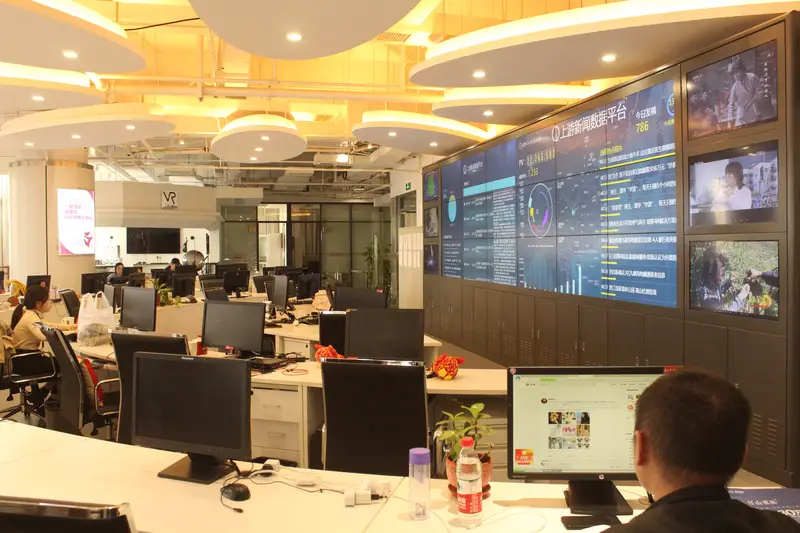Staff working at the huge digital interactive panel in Chongqing District New Media Group. (Photo: Harsha Udayakantha Peiris)
In China, media convergence is rapid and an expedited process.
"We need to build a number of new and competitive mainstream media with diverse forms and advanced means, and form a modern communication system that is three dimensional, diverse and integrated," says Prof.Chen Jing of the Chongqing Normal University in China.
Strengthening internet thinking and complementing the strengths of the old and new media are two mainly important strategic factors in this regard. Collaboration of user thinking, traditional media technology content and user’s trust in new media are pivotal in such platforms.
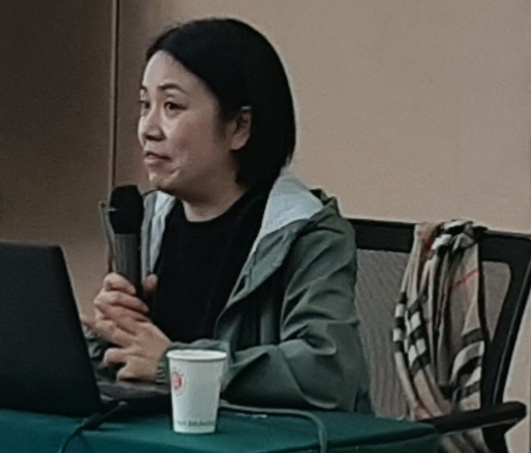
Prof.Chen Jing
"Although we know convergence is to bind the conventional media with new media, we cannot foretell the future of convergence media. Media convergence strengthens the combination with new media. In the past, conventional media content was usually biased as the institutional view point was imperative in most of what was published. But with the introduction of new media at present, the published content cares more about its users than the past. This realizes the fact that public trust in the media is very essential in an era of media convergence for reliable information dissemination," Prof.Chen observed.
Establishing the concept of integrated development and promoting in-depth integration of media is highly valued in media convergence. Media content, its platform, channel of dissemination, terminal talent of HR management and its aspects of intelligence are other essential components of this integration.
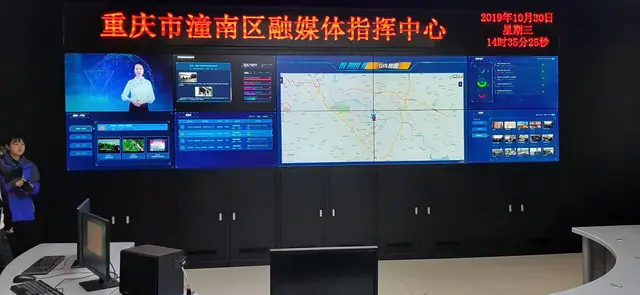
The digital interactive media panel at Chongqing Tongnan District Media Group that utilizes GIS. (Photo: Harsha Udayakantha Peiris)
In Chongqing, the Tongnang District Media Group, the fastest information disseminator in China’s Chongqing province, a huge digital panel is the base platform of news gathering, media staff allocation and dissemination.
The technology mainly utilizes Geo Information Systems (GIS). Sooner the information on a situation is reported, GIS is used to locate the nearest journalist to the scene with a duty to report.
As the journalist or the reporter captures information on video, picture or text, it is immediately sent via his android mobile phone to the base station and within a minimum time, it is re-analyzed for confirmation of location it actually occurred.
Since Chongqing is a land area distributed in a vast geographical array, 2 dimensional mapping on GIS is the main source of such confirmation.
Then the received news is edited and after obtaining required approvals, it is sent back to the main digital monitoring panel where it is re-branched for distribution and transmission to live telecast in Chongqing district New Media Group’s television channels and other member news agencies across the mainland of China.
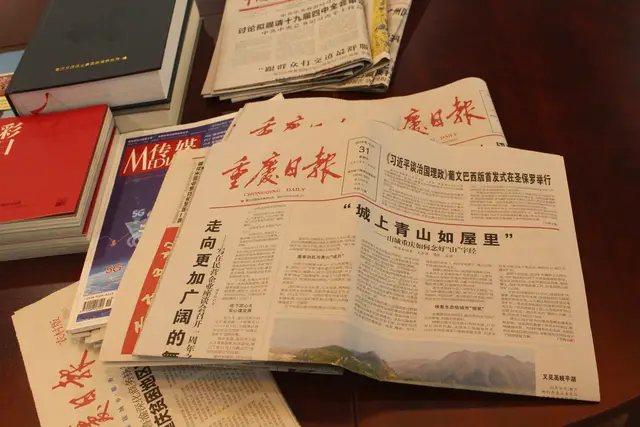
Chongqing Daily Newspaper
Chongqing District New Media Group also publishes a newspaper that has been converged with new media.
The use of cable television broadband network and Internet Protocol Television (IPTV), to achieve home domain network coverage, has helped build a smart home concept and smart communities in China.
At present, China’s Chongqing province is becoming a success story in such media implementations. After the completion of Chongqing audio-visual system, soon it will provide a platform for quicker, one-click shooting to provide news clues and revelations, support of broadcasting for radio and television reception to create more social interaction, games, shopping and other value added services and functions.
The launch of ‘Palm Broadcast’ app client is a successful development in Chongqing in this regard. Hence, channel transformation is carried out on some recently started television channels to transform them from a single broadcasting platform into an operating channel.
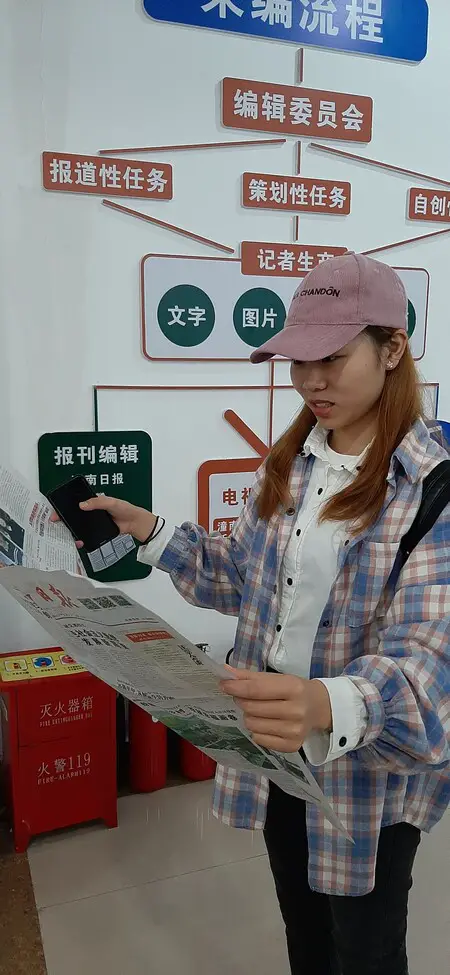
Convergence has also reduced the number of pages of a newspaper published by a press institution in China. (Photo: Harsha Udayakantha Peiris)
Through the integration of channels into various media, a new online and offline integrated operation has been created.
Due to effective media convergence, not only the content and quantity of newspaper printing but also the publishing cycle has also decreased at large. Some daily newspapers in China are now published only twice a week. And interestingly, convergence has also reduced the number of pages of a newspaper published by a press institution. The newspaper published by Chongqing District New Media Group has only four pages.
“In the press house, we now have robots who can interview and edit news. We also use drones and offer drone training to our reporting staff in our workshops. That is the new trend here in media convergence. This type of practice offers transition training for traditional journalists to effectively transfer from conventional media to new media. This transformation of employees from conventional media to new media is important to sustain employment and the existence of media institutions such as press houses as well,” Prof. Chen said.
According to guidelines extended by the Chinese President Xi Jinping in 2014, Chinese media has followed a three staged process in convergence. The three stages include the availability of both conventional and new media as well as both media going into each other and integration as one.
According to Tian Hongming, a renowned and an experienced media practitioner and a lecturer at the Chongqing Normal University in China, Chinese media is now in stage 2.5, preferably integrating into each other.
“In another few years’ time we will see a full bloom in this process where in China you will see new media playing both roles. In the newspaper industry, one day, paper may vanish, but news will remain forever,” he said.
In China in 2018, 1,76 million tons of newsprint was consumed, compared with 1.92 million tons in 2017, an year-on-year decrease of 8.33%. Statistics show that 44 newspapers were closed in China in 2018 but 1884 still exist.
In 2015, China’s internet media advertising exceeded the total advertising revenue of television, newspaper, radio and magazine for the first time, marking an industry watershed.
Combination of media with other industrial sectors such as marketing economy and finances is also an essential part of media convergence. At the same time, media convergence has effectively increased time efficiency in media practices and publishing in all platforms.
China has a population of 1.3 billion out of which 01 billion are ‘We Chat’ users. At present, China’s concerns have also driven towards a global media convergence.

(Harsha Udayakantha Peiris)

